In this article, we are going to analyze how to draw SbF3 and various facts about it.
SbF3 or antimony trifluoride is an inorganic compound which has ionic type of bonding. So the bonding can be explained by the concept of lewis dot structure. So we will study the sbf3 lewis structure in detail and various facts related to it in the following sections.
SbF3 facts and properties
The IUPAC nomenclature of SbF3 is trifluorostibane, it is also referred to as Swarts reagent. In appearance, it exists as light grayish or sometimes white colored crystals and has a density of 4.379 g/cm3.
It’s observed molecular weight is 178.76 g/mol and has a pungent kind of odor. The melting point of SbF3 is around 292 degrees Celsius and boils at a temperature of 376 degrees Celsius.
Talking about its solubility it can dissolve in water but solubility differs with temperature. The solubility at a temperature of zero degrees Celsius is 385 g/100 mL. The solubility at 20 degrees Celsius is 443 g/100 mL. The solubility at 30 degrees Celsius is 562 g/100 mL. It is also soluble in organic compounds like acetone, methanol, etc. It has an orthorhombic crystal structure. It can be prepared by reacting antimony trioxide and hydrogen fluoride.
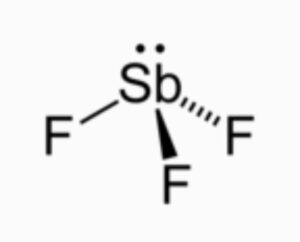
Image credit: Wikipedia
Taking into account its applications it is usually used as a reagent (fluorination) in chemistry (organic). This was first discovered by Fredric J.E Swarts in the year 1892 (as to how it can be used for the conversion of chlorides into fluorides). Where antimony trifluoride was treated with chlorine which gave or produced trifluorodichloride. This is the Swarts reaction which is usually employed in the production of compounds of organofluorine.
How to draw lewis structure for SbF3?
We must know the number of valence electrons in order to draw the structure. So the number of valence electrons in antimony trifluoride.
According to the formula there is one antimony and three fluorine atoms in the structure. The number of valence electrons in antimony are 5 and in fluorine, there are 7 (as there are three fluorine atoms in the molecule, the number of valence electrons will be 7×3=21 electrons). So total number of valence electrons in the molecule will be 5+21=26 electrons. Now we have to identify the atom that has to be placed in the center, so the central atom is the one that has the least electronegativity.
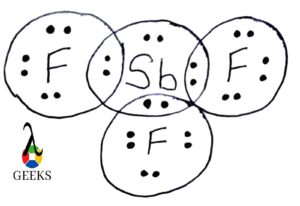
In this molecule, antimony will be the central atom, and the rest (fluorine) atoms will be the surrounding ones. As we can see, the dots around the atoms represent the number of valence electrons. So the dots are placed in a manner that it satisfies the valency of the bonding atoms. Hence in each bond fluorine and antimony both contribute one electron each and thus satisfy each others valency. As only one pair of electrons is involved in the formation of bond the resulting bond is a single bond.
SbF3 lewis structure shape
Taking into account the SbF3 lewis structure shape, it has a trigonal pyramidal shape.
So how can we say or conclude that it has trigonal pyramidal? What we mean by trigonal pyramidal geometry is that one of the atom is placed at the apex and the remaining three are placed at the corners of the trigonal base which resembles a tetrahedron. So in the structure. There is one antimony atom and three fluorine atoms, the antimony is the central atom and the rest are the fluorine atoms.
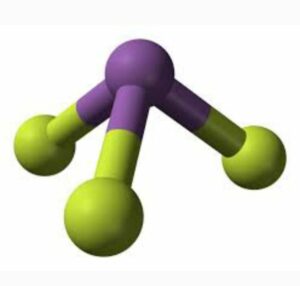
So it’s coordination number is 3. The bond angle ranges from 90 degrees to somewhere around 109.5 degrees.
SbF3 Lewis structure formal charge
A formal charge on any atom is the difference in between number of valence electrons (includes every atom) and the associated number of electrons. It is assumed by the formal charge that any electrons that are shared are shared equally between two bonding atoms. The formal charge is calculated by using the below formula:
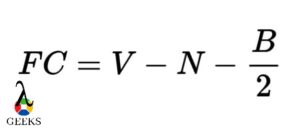
Where, the term V means number of valence electrons contributed by the atom (as though isolated from a molecule).
The term N means number of unbound (valence electrons) on atom that is being considered of molecule.
The term B means the total number of electrons that are shared by bonds with the other atoms in molecule.
So, considering the molecule of SbF3 the formal charge on Sb is zero and on Fluorine is also zero. Hence the formal charge on the entire molecule will be zero.
SbF3 Lewis structure lone pairs
A lone pair means pair of valence electrons which are not shared during the process of bonding.
They are meant to be found in the outermost (electron) shell of the atoms. We can say that the number of lone pairs around any atom when added to the number of electrons participating in bonding equals to the number of valence electrons in the atom. The concept of lone pair is of VSEPR (valence shell electron repulsion theory). Coming to the molecule of SbF3 there is one lone pair present.
SbF3 hybridization
Hybridization is the concept/process of mixing the atomic orbitals in order to form new orbitals (hybrid) which have much different shape, energy.
(Hybrid orbital formation is possible when the atomic orbitals have comparable kind of energies). This formed (hybrid) orbitals can be used to explain properties like atomic bonding and geometry (molecular). The hybridization in SbF3 molecule is sp3.
At the ground state, there are two electrons in the 5s orbitals and three electrons in 5p orbitals. And then the new hybrid orbitals are formed with three fluorine atoms.
SbF4 lewis structure resonance
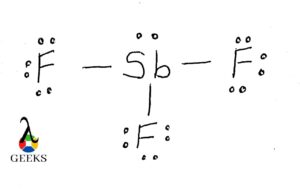
SbF3 Lewis structure octet rule
According to the octet rule, an atom wants to obtain a completely filled octet. Meaning there should be total of 8 electrons present in the outermost shell. This is the reason Sb forms single bonds by sharing one electron pair each with 3 fluorine atoms. That is the reason atoms share their valence electrons, so that they can have a complete octet meaning their valency is satisfied.
Also Read:
- So lewis structure
- Secl4 lewis structure
- Na2o lewis structure
- Ca3n2 lewis structure
- Hcl lewis structure
- Br3 lewis structure
- Kclo4 lewis structure
- Nahco3 lewis structure
- Hcooh lewis structure
- Mgso4 lewis structure
This is Sania Jakati from Goa. I am an aspiring chemist pursuing my post graduation in organic chemistry. I believe education is the key element that moulds you into a great human being both mentally and physically. I’m glad to be a member of scintillating branch of chemistry and will try my best to contribute whatever I can from my side and Lambdageeks is the best platform where I can share as well as gain knowledge at the same time.